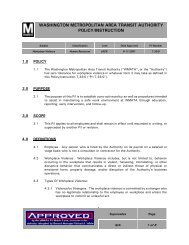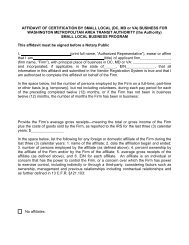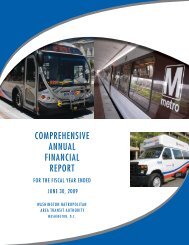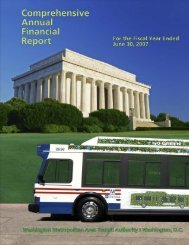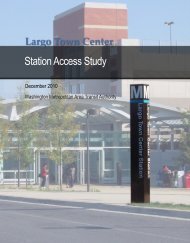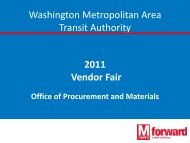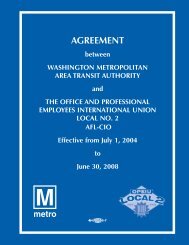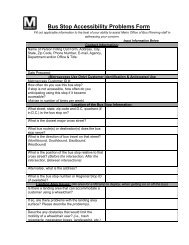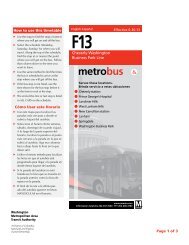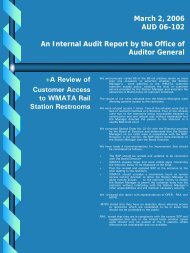Naylor Road Metro Station Area Access and Capacity - WMATA.com.
Naylor Road Metro Station Area Access and Capacity - WMATA.com.
Naylor Road Metro Station Area Access and Capacity - WMATA.com.
Create successful ePaper yourself
Turn your PDF publications into a flip-book with our unique Google optimized e-Paper software.
Advantages<br />
• Increases convenience for existing bus passengers<br />
• Encourages Park & Ride customers to take the bus<br />
• Attracts new bus riders<br />
• Can increase rail ridership<br />
Disadvantages<br />
• Increases capital <strong>and</strong> operating costs of new <strong>and</strong> enhanced bus services<br />
• Potential service cuts during poor economic conditions<br />
Options<br />
Options are groups of strategies designed to achieve one of the following out<strong>com</strong>es: shift,<br />
replace, or exp<strong>and</strong> parking. This study recognizes that there are multiple approaches to<br />
achieving these out<strong>com</strong>es, <strong>and</strong> presents nine total options (Table 30). The goal for each option<br />
is to balance Park & Ride access dem<strong>and</strong> with <strong>Naylor</strong> <strong>Road</strong> <strong>Station</strong>’s future as a TOD regional<br />
center. Assumptions previously outlined apply to all options, including that existing station<br />
area pedestrian <strong>and</strong> bicycle re<strong>com</strong>mendations will be addressed in the final TOD site plan.<br />
Note that enhanced bus connectivity is a strategy in every option. Regardless of which option is<br />
pursued for <strong>Naylor</strong> <strong>Road</strong> <strong>Station</strong>, bus connectivity should be enhanced to meet estimated future<br />
dem<strong>and</strong>. Enhanced bus services would further energize the station area with opportunities<br />
for further activity outside the peak periods, something that the peak-only nature of a Park &<br />
Ride facility would not provide. As shown in Figure 57, bus transfers to <strong>Metro</strong>rail are not as<br />
heavily concentrated in the morning peak as Park & Ride passengers, nor as concentrated in the<br />
afternoon peak as passengers who arrive by walking.<br />
Table 30: Summary of Options<br />
Strategies<br />
All-in-one access facility (bicycle, bus, Kiss & Ride,<br />
<strong>and</strong>/or Park & Ride within the same garage)<br />
Developer-constructed garage with reserved transit<br />
parking in a mixed-use building<br />
Developer-constructed parking garage with shared<br />
transit parking in a mixed-use building<br />
Publicly-owned satellite parking facility with feeder<br />
transit service to Green Line stations<br />
Satellite parking through shared-use agreements with<br />
feeder transit service to Green Line stations<br />
Additional parking to other Green Line stations<br />
Out<strong>com</strong>es<br />
Shift Parking Replace Parking Exp<strong>and</strong> Parking<br />
Options<br />
A1 A2 A3 B1 B2 B3 C1 C2 C3<br />
Real-time parking information<br />
Preferred carpool parking <strong>and</strong>/or discounts<br />
Enhanced bus connectivity<br />
<strong>Naylor</strong> <strong>Road</strong> <strong>Metro</strong> <strong>Station</strong> <strong>Area</strong> <strong>Access</strong> <strong>and</strong> <strong>Capacity</strong> Study | 70





